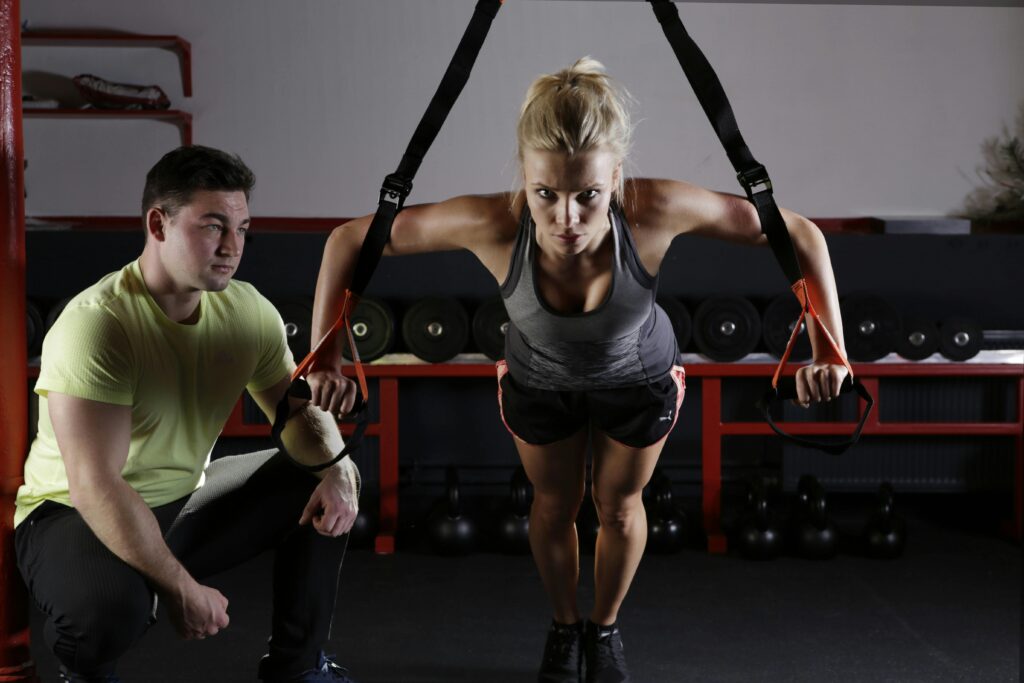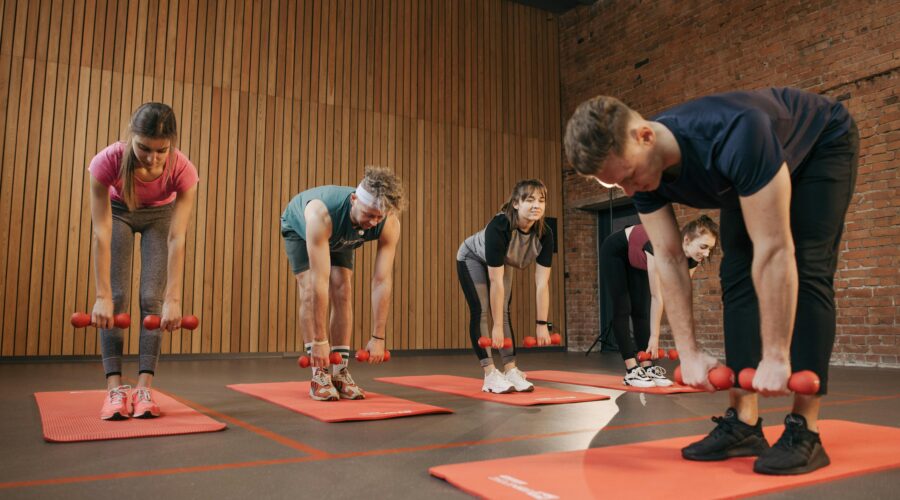Weightlifting might seem intimidating if you’re just starting out, but it’s one of the most rewarding ways to boost your strength, confidence, and overall health. Whether you’re looking to get toned, build muscle, or just feel more empowered, this guide will walk you through the basics of strength training in an engaging, easy-to-follow, and fun way.
In this post, we’ll cover the benefits of strength training, how to get started safely, and tips for creating a balanced workout plan. By the end, you’ll have a clear roadmap for embarking on your weightlifting journey, all while keeping your body safe and healthy.

1. The Many Benefits of Strength Training
Before diving into the “how” of weightlifting, let’s look at the “why.” Strength training is about more than just bulging muscles or lifting heavy weights. Here are some compelling reasons to add it to your fitness routine:
Physical Health Benefits
- Increased Muscle Strength: As you lift weights, your muscles get stronger, which helps in everyday tasks and boosts your metabolism.
- Bone Density Improvement: Regular weightlifting can reduce the risk of osteoporosis by strengthening your bones.
- Enhanced Metabolic Rate: More muscle means more calories burned even when you’re resting, making weight management easier.
- Improved Joint Function: A strong support system around your joints can reduce the risk of injury and improve overall mobility.
Mental and Emotional Perks
- Stress Relief: Exercise, including weightlifting, releases endorphins—your body’s natural “feel-good” chemicals.
- Boosted Confidence: Achieving personal milestones, no matter how small, can greatly improve self-esteem.
- Improved Focus and Discipline: Following a structured workout plan builds mental resilience and focus that can translate into other areas of life.
Lifestyle and Social Benefits
- Community and Support: Many people find a sense of community in gyms or fitness classes, making workouts more enjoyable.
- Empowerment: Knowing you’re actively working on your strength can make you feel more in control of your health.
- Longevity: Research has shown that strength training contributes to a longer, healthier life.
Taking these benefits into account, it’s clear why weightlifting is a great addition to your fitness routine. But, as with any physical activity, it’s important to start safely.

2. Getting Started Safely
Jumping headfirst into weightlifting without proper preparation can lead to injuries. Safety should be your number one priority. Here’s how to begin your journey the right way:
Consult a Professional
Before beginning any new exercise regimen, especially if you have any pre-existing health conditions or injuries, consult with your doctor or a fitness professional. They can help tailor a program to your specific needs.
Start With a Fitness Assessment
Understanding your current level of fitness is key. A fitness assessment, which might include checking your flexibility, balance, and strength, will give you a baseline to build from. Many gyms offer a free initial assessment, or you can do a self-assessment with simple exercises at home.
Learn Proper Form
Incorrect form can turn a good workout into a recipe for injury. Consider taking a few sessions with a personal trainer or joining a beginner’s class to learn the fundamentals of weightlifting. There are plenty of quality online tutorials too, but nothing beats hands-on guidance when you’re starting out.
Invest in Good Equipment
You don’t need a fully equipped gym to start weightlifting, but investing in a few key pieces can make your workouts safer and more effective:
- Quality Shoes: Proper athletic shoes help prevent slips and provide necessary support.
- Comfortable Clothing: Wear something that allows for a full range of motion.
- Basic Equipment: Dumbbells, resistance bands, or a kettlebell can get you started without breaking the bank.
Warm-Up and Cool Down
A proper warm-up gets your muscles ready for the workout ahead, while a cool down helps your body recover. Start each session with 5-10 minutes of light cardio or dynamic stretching, and end with static stretches focusing on the muscles you worked.
Listen to Your Body
Perhaps the most important rule is to listen to your body. If something feels off or if you experience pain (beyond normal muscle fatigue), stop and assess. It’s okay to take breaks and adjust your plan as needed. Remember, progress takes time, and safety is paramount.

3. Building a Beginner’s Weightlifting Routine
Once you’re comfortable with the basics and have consulted a professional, it’s time to build a routine. Here’s a simple plan that emphasizes safety while still being effective:
Week 1-2: Getting Acquainted
Goal: Learn the basic movements and build a foundation.
- Frequency: Aim for 2-3 workouts per week.
- Focus: Full-body workouts that include compound movements.
- Exercises:
- Squats: Start with bodyweight squats to master the form.
- Push-Ups: Begin on your knees if needed and progress to full push-ups.
- Dumbbell Rows: Use light dumbbells to learn the correct rowing technique.
- Planks: Build core strength with planks; hold for 20-30 seconds initially.
Week 3-4: Introducing Resistance
Goal: Gradually increase resistance while maintaining proper form.
- Frequency: Continue with 2-3 workouts per week.
- Focus: Continue full-body routines, but add more resistance.
- Exercises:
- Dumbbell Squats: Hold light dumbbells at your sides or at your shoulders.
- Bench Press (or Dumbbell Chest Press): Use a light weight to focus on technique.
- Deadlifts: Start with a light kettlebell or dumbbell to learn the movement.
- Shoulder Press: Incorporate light dumbbells to strengthen your shoulders.
- Sets and Reps: Aim for 2-3 sets of 10-12 reps for each exercise.
Week 5 and Beyond: Building Consistency and Confidence
Goal: Start increasing weights gradually and target specific muscle groups.
- Frequency: 3-4 workouts per week.
- Focus: Split routines can allow for more focus on each muscle group.
- Sample Split Routine:
- Day 1: Upper Body: Focus on chest, shoulders, and triceps.
- Day 2: Lower Body: Concentrate on legs and glutes.
- Day 3: Rest or Active Recovery: Light cardio or stretching.
- Day 4: Full Body/Compound Movements: Combine multiple muscle groups.
- Day 5: Core and Flexibility: Incorporate planks, leg raises, and yoga or Pilates moves.
- Progressive Overload: Gradually increase the weight or resistance as your muscles adapt. Small increments are key—don’t rush it!
Tips for a Successful Routine
- Keep a Journal: Tracking your workouts, weights, and reps can help you see progress over time.
- Rest and Recovery: Muscles need time to repair. Ensure you’re getting adequate rest between workouts.
- Stay Hydrated and Eat Well: Nutrition plays a crucial role in strength training. Aim for a balanced diet rich in proteins, carbohydrates, and healthy fats.
- Mix It Up: Avoid plateaus by varying your exercises and routine every few weeks.

4. Fun Ways to Stay Motivated
Embarking on a new fitness journey can sometimes feel overwhelming. Here are some creative ways to keep the fun alive and stay motivated:
Set Realistic Goals
Break your long-term vision into smaller, achievable milestones. Maybe it’s mastering a specific exercise, lifting a certain weight, or simply completing a set number of workouts each month. Celebrate every victory, no matter how small.
Find a Workout Buddy
Training with a friend can make workouts more enjoyable. A buddy can offer encouragement, help correct your form, and provide a healthy dose of competition that pushes you to do your best.
Explore Different Workouts
Don’t feel tied down to a single routine. Explore classes, follow online workouts, or try out different gyms to keep your routine fresh. Experimenting with variations of weightlifting or combining them with other activities (like yoga or cardio circuits) can add a fun twist to your regimen.
Join a Community
Online forums, local fitness groups, or gym classes can provide a support network. Sharing experiences, challenges, and successes with others can be incredibly motivating and help you stay accountable.
Reward Yourself
Set up a reward system for achieving your milestones. Whether it’s a new workout outfit, a massage, or a fun day out, having something to look forward to can boost your motivation.

5. Overcoming Common Challenges
No journey is without its hurdles. Here are some common challenges faced by beginners—and how to overcome them:
Dealing with Soreness
It’s normal to experience muscle soreness, especially when you’re new to weightlifting. Use foam rollers or gentle stretching to help alleviate the discomfort. Over time, your body will adapt, and you may even come to appreciate that “good soreness” as a sign of progress.
Time Management
In today’s fast-paced world, finding time to work out can be challenging. Consider shorter, more intense workouts if you’re strapped for time. Even 30-minute sessions can be effective if you’re consistent and focused.
Plateaus in Progress
It’s common to hit a plateau where progress seems to stall. When this happens, mix up your routine. Try new exercises, increase the weight gradually, or even take a brief break to let your body reset before pushing again.
Fear of Injury
The fear of injury is a major deterrent for many beginners. Focus on learning proper form first, and don’t be afraid to ask for help from trainers or experienced lifters. Remember, safety is your top priority, and it’s always better to progress slowly than risk a setback.
Balancing Strength Training With Other Goals
If you’re also into cardio, flexibility training, or other forms of exercise, it can be a challenge to balance them with your weightlifting routine. Consider planning your week to allocate specific days for each type of exercise. This balanced approach not only keeps your workouts fun but also helps prevent burnout and overtraining.

6. Strength Training Myths Debunked
There are plenty of misconceptions about weightlifting, and debunking them can help you approach your training with confidence:
Myth 1: “Lifting weights will make you bulky.”
For most beginners, especially women, weightlifting won’t result in the bulky look often depicted in movies or magazines. Strength training is about improving muscle tone and overall strength. Building significant muscle mass takes time, and genetics play a huge role.
Myth 2: “You need fancy equipment or a gym membership.”
Many exercises can be done with minimal equipment, even at home. Bodyweight exercises like push-ups, squats, and planks are highly effective. Once you’re comfortable, a few dumbbells or resistance bands can expand your routine without requiring a full gym setup.
Myth 3: “Cardio is all you need for fitness.”
While cardio is important for heart health, strength training is essential for building muscle, boosting metabolism, and ensuring overall functional fitness. A balanced workout routine includes both cardio and strength exercises.
Myth 4: “You can out-train a bad diet.”
No matter how hard you work out, nutrition plays a critical role in your progress. Focus on a balanced diet with adequate protein, healthy fats, and complex carbohydrates to support your training and recovery.

7. Real-Life Success Stories
There’s nothing more motivating than hearing about others who have taken the leap into weightlifting and reaped the rewards. Here are a few inspirational stories from everyday beginners:
Sarah’s Journey
Sarah started strength training after years of feeling fatigued and out of shape. With guidance from a local gym’s beginner class, she learned the basics and steadily built up her confidence. Within months, she was not only lifting heavier weights but also noticing improvements in her energy levels and overall mood. “I feel empowered every time I finish a workout,” Sarah says. Her journey is a testament to the transformative power of strength training.
Mike’s Transformation
Mike, a busy professional, found it hard to carve out time for exercise. Determined to improve his health, he began with 20-minute home workouts. By gradually increasing his weights and integrating a few strength training sessions into his weekly routine, Mike lost weight, built muscle, and improved his posture. “The best part is that I can track my progress,” he explains. His story is proof that even with a hectic schedule, consistent effort can yield impressive results.
Lisa’s Leap of Faith
After years of avoiding the gym due to self-consciousness, Lisa decided to give weightlifting a try. With the support of a friend and a patient trainer, she overcame her fears and began her journey. Today, Lisa not only enjoys her workouts but also mentors others who are just starting out. “It’s amazing how much strength training has boosted my confidence,” Lisa shares. Her experience underscores that strength training is not just about physical gains—it’s about transforming your mindset.

8. Crafting Your Personal Strength Training Philosophy
Every fitness journey is unique, and part of the fun is discovering what works best for you. Here are some tips for developing a training philosophy that resonates with your lifestyle:
Embrace the Process
Understand that strength training is a journey, not a race. There will be days of progress and days when you feel like you’re backtracking. Embrace both, as each session is a step toward a stronger you.
Celebrate Small Wins
Whether it’s increasing the weight on your bench press by 5 pounds or holding a plank for an extra 10 seconds, celebrate your progress. Small victories are the building blocks of long-term success.
Customize Your Routine
Not every workout has to follow a strict template. Mix in your favorite exercises, try new routines, and listen to your body’s feedback. The more you tailor your workouts to your interests and needs, the more likely you are to stick with them.
Learn Continuously
Fitness trends and techniques are always evolving. Read articles, watch tutorials, and, most importantly, ask questions. The more you learn, the better you can refine your approach to training.
Mindset Matters
A positive mindset can be a game changer. Instead of focusing on limitations, celebrate your capabilities. If you ever feel discouraged, remind yourself why you started and look back at your progress with pride.

9. FAQs for the Weightlifting Beginner
As you embark on your strength training journey, you might have questions. Here are some frequently asked questions along with answers that might help clear up any doubts:
Q: How often should I strength train as a beginner?
A: For beginners, 2-3 sessions per week is a great start. This allows your body time to recover between sessions while still building strength.
Q: What are the best exercises to start with?
A: Focus on compound movements such as squats, push-ups, rows, and deadlifts. These exercises work multiple muscle groups and lay a strong foundation.
Q: Can I build muscle without lifting heavy weights?
A: Absolutely! Consistency, proper form, and gradually increasing resistance will help you build muscle even if you’re not lifting heavy right away.
Q: How do I avoid injuries?
A: Start slow, use proper form, warm up and cool down, and listen to your body. If you’re ever unsure, consult a professional for guidance.
Q: Do I need a gym membership to start weightlifting?
A: Not necessarily. Many effective strength training exercises can be done at home with minimal equipment. As you progress, you may choose to join a gym for more variety in equipment and classes.

10. Final Thoughts: The Journey to Strength
Weightlifting is not just a form of exercise—it’s a journey of self-discovery, empowerment, and health. As you step into the world of strength training, remember that progress is a personal journey. Celebrate each step, whether it’s mastering a new exercise, feeling more energetic, or even just developing a healthier relationship with your body.
Take your time, listen to your body, and don’t be afraid to ask for help when you need it. With consistency, patience, and a positive mindset, you’ll soon find that the weights aren’t just tools for building muscle—they’re instruments for building a stronger, more resilient you.
So lace up your sneakers, grab your weights, and get ready to transform not only your body but also your mind. Your journey to strength starts today!
By integrating science, practical tips, and a bit of personal touch, this guide aims to demystify weightlifting for beginners while ensuring you’re well-equipped to start safely. Remember, every expert was once a beginner. So, be kind to yourself, enjoy the process, and let each workout bring you one step closer to the strong, confident version of you that’s waiting to emerge.




